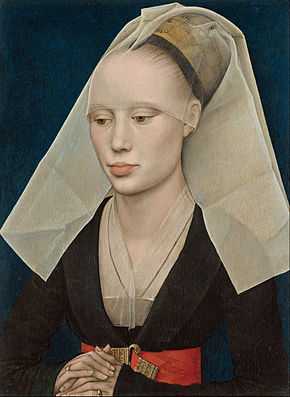Virgin and Child Enthroned (van der Weyden)
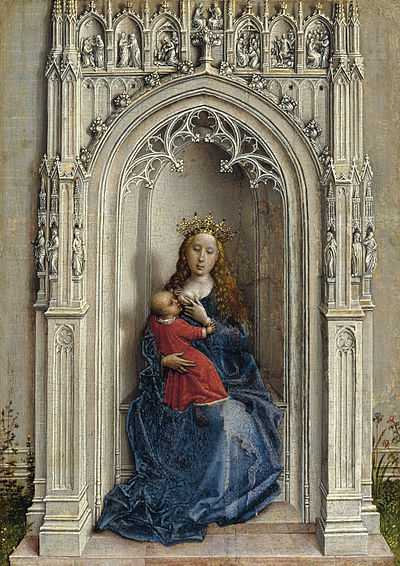
The Virgin and Child Enthroned (or the Thyssen Madonna or Madonna in an Aedicula) is a small oil on oak panel painting attributed to the Flemish artist Rogier van der Weyden dating from about 1430–32. It is closely related to his The Madonna Standing completed during the same period. It may have formed the left hand wing of a later dismantled diptych, perhaps with the Saint George and the Dragon now in Washington. It shows considerable influence from Robert Campin, under whom van der Weyden trained, notably in the architecture of the niche, the facial type, exposed breast and hair of the Virgin, and the use of painted grisaille figures representing sculptures.
The image is highly compact from a temporal point of view, and contains imagery of prophets, the Annunciation to Mary, the infant Christ, his nursing, resurrection and Mary's eventual crowning in heaven. The work is generally accepted as the earliest extant work by van der Weyden, and is one of three works attributed to him that shows the Virgin and Child enclosed in a niche. As an early work, it betrays its influences, notably from Campin and Jan van Eyck; especially noticeable are motifs borrowed from the latter's Ghent Altarpiece.
Diptych
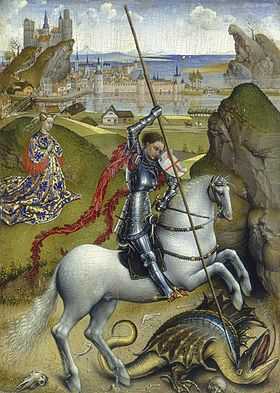
Some art historians have speculated that the panel was the left hand wing of a dismantled diptych, with the Washington Saint George and the Dragon of 1432–35 offered as the most likely opposite wing.[1] In that work, St. George, facing inwards and to the right, slays the dragon before a decidedly unexcited Libyan princess. Although the pairing might seem unlikely and incongruous, the artist's Madonna Standing is widely thought to have been attached with the St. Catherine of Alexandria in Vienna.[1]
Shirley Blum suggests that van der Weyden was establishing a juxtaposition between the otherworldly setting of the Madonna and Child and the earthly setting and historical dress of the saints. In both ancillary panels, the saints face inwards and away from the right hand painting. In both, they are positioned within fully realised landscapes, setting them in an earthly realm. In contrast, in both left hand panels, the Madonna and Child are positioned frontally (although eye contact is avoided) and isolated within cold grisaille architectural spaces. Blum describes the couplings as serving to position each saint "as a 'living witness' to the static, eternal presence of the Virgin and Child." She goes on to state that, "Only in such early works do we find this kind of obvious solution. By the time of the Descent and the Prado Madonna, Van der Weyden has already worked out a far more complex and effective means of mixing temporal and non-temporal effects".[2]
Description
_Detail3.jpg)
The painting is a Madonna Lactans and at 18.5cm x 12cm the smallest extant work by van der Weyden. It is bathed in very soft light, an influence from van Eyck. Falling from the right, the light leaves shadows of both Mary and the Child's heads on the wall of the niche.[3] The Virgin and Child are shown seated in a small Gothic chapel or oratory projecting from a wall and opening onto a lawn. The painting plays very close attention to small realistic detail; for example there are four small holes above each arch, likely intended to hold scaffolding.[4] There are some difference in symmetry between the left and right hand sides of the painting. This is most noticeable with the buttress, where the receding edges are over half again the size of those on the front sides. In addition, the breath of the buttress contradicts the spatial dept of the much tighter space inhabited by the Virgin and Child. Ward notes this is an issue with foreshortening that Campin also struggled with, though van der Weyden did overcome in his more mature work.[5]
A deliperate motif is that the depiction of the chapel is plainly unrealistically small; van der Weyden's intention was to maintain the preponderance of the Virgin over her shrine while symbolically representing the Church and the entire doctrine of the Redemption.[6] It is one three surviving van der Weyden's where the Madonna and Child are enclosed in this way. However it is unusual in that the niche exists as a separate feature within the picture, compared to the two other works where the enclosure is coterminous with the edge of the painting, almost as part of the frame. This is one reason why it is thought to predate The Madonna Standing.[3]
_-_WGA25572.jpg)
The Virgin appears far too large in comparison to the aedicula in which she sits; a very van Eyckian device, later to reappear in his Prado Descent.[7] Her blond hair is unbounded and falls across her shoulders and down to her arms. Betraying the influence of Campin, it is brushed behind the ears.[3] She wears a crown as Queen of Heaven and a ring on a finger as the Bride of Christ.[6] Reinforcing this, the blue colour of her robe alludes to her devotion and fidelity to her son.[8] The crisp folds of her dress are reminiscent of the lengthy and curved intertwine of gowns in Gothic sculpture.[4]
Christ is dressed in a red garment, as opposed to the swaddling he usually wears in 15th century Virgin and Child portrayals.[9] This painting represents one of two exceptions where he is fully clothed; the other is Campin's Madonna in Frankfurt, where he is shown in blue clothing.[10]
As with other early van der Weyden Madonna panels, her head is slightly too large for her body. Her dress is creased and resembles the almost paper-like crisp folds associated with Northern art of that time. However, the description of her lap contains inconsistencies also seen in Campin's Virgin and Child before a Firescreen. The Madonna's lap appears to be bulk-less, as if she has only one leg. This seems to reflect the young artist's difficulty both with foreshortening and the difficulty of depicting a body under clothing.[5]
Iconography
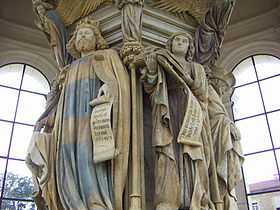
The work is rich in symbolism and iconographic elements, to an extent far more pronounced than that in the The Madonna Standing. An iris grows to the side of the aedicula, representing the Virgin's sorrow at the Passion, and on the other side a columbine, recalling the Sorrows of the Virgin.[6] This symbolic use of flowers is again a van Eyckian motif. While they may appear incompatible with the architectural setting, this was probably the effect that van der Weyden was seeking.[11]
The lintel contains six reliefs of scenes from the New Testament showing the Life of the Virgin Mary. The first four, the Annunciation, the Visitation, the Nativity and the Adoration of the Magi, are associated with motherhood and infancy. They are followed by the Resurrection and Pentecost. Above them, surmounting a "cross flower", is the Coronation of the Virgin.[6][9]
_Detail2.jpg)
The jambs on either side of the Virgin are adorned with statues representing the prophets of the Old Testament. The figures are mostly unidentified; only David, standing second to the left, can be identified, because he holds a harp. Reasonable deductions can be made as to the other figures, based on their sequence in relation to typical representation of such biblical personages in this manner. The bearded figure to his left is probably Moses, the man in the cap to David's right most likely the "weeping prophet" Jeremiah. On the opposite side, the outer figures may be the prophets Zechariah and Isaiah.[8]
By portraying these figures in grisaille, van der Weyden is making a distinction between the earthly, who are rendered as in flesh, and the divine, depicted frozen in time, as imitation sculpture.[11] Blum believes these figures were relegated to the architectural elements so as not to crowd the central devotional image.[7] The arrangement of these six figures may have been influenced by Claus Sluter's Well of Moses at the Chartreuse de Champmol, which has a similar alignment. In Champmol the prophets represent the judges of Christ (Secundum legem debet mori) and are thus tied to the crucifixion. In van der Weyden's work they are associated with the Virgin.[8] The motif of portraying figures in niches has a long tradition in Northern art; however, rendering them as sculpture was unique to the 1420s and 1430s, an innovation most notable in Jan van Eyck's Ghent Altarpiece. That work is perhaps in turn derived from Campin's 1420 Saint James the Great and Saint Claire, now in the Museo del Prado, Madrid.[3]
Attribution
.jpg)
The work closely resembles his The Madonna Standing from the same time, but also seems influenced by the work of Robert Campin under whom he served his apprenticeship. It especially resembles Campin's 1430 Virgin and Child before a Firescreen, now in London, and one of the last works Campin completed before van der Weyden left his studio.[3] In both works the Virgin has large breasts, with fingers pressed to them to feed the Child. There are further similarities in her facial features, expression, her hair colour, its style and fall, as well as in her pose.[7] Lorne Campbell attributes the work largely to van der Weyden's workshop,[12] while John Ward argued in 1968 that the Thyssen Madonna was in fact by Campin and should be dated 1435.
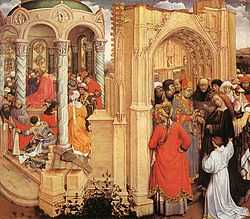
Ward's thesis is based on the fact that the Thyssen panel is overwhelmingly influenced by Campin, while the contemporaneous and more sophisticated Madonna Standing draws heavily from van Eyck. He finds such a sudden shift unlikely, while also pointing out that this work evidences some technical difficulties that Campin was never to resolve, especially in respect to foreshortening and the rendering of the body underneath clothes. He also points to the architectural similarities to Campin's Marriage of Mary, although this may be a matter of influence.[13]
Dating
If the attribution to van der Weyden is accepted, then the piece was completed early in his career, probably just after he completed his apprenticeship with Robert Campin. Although highly accomplished and beautiful, it is perhaps filled with direct and obvious symbolism of a kind absent from his more mature works. It is one of three attributed paintings, all early works, that show the Virgin and Child set within an architectural setting, surrounded with painted sculptural figures, the other two being The Madonna Standing and the comparatively simplified but perhaps more effective Durán Madonna of 1435–38.[10][10]
Sculptural figuration was to become a hallmark of van der Weyden's mature work, and is best typified by the c. 1435 Madrid Descent, where the mourning figures are shaped and take on poses more usually seen in sculpture.[7] Erwin Panofsky identified this work and the The Madonna Standing as van der Weyden's earliest extant work; they are also the smallest attributed panels. Panofsky dated both panels as 1432–34, and believed them to be early works based on stylistic reasons, their near miniature scale, and because of the evident influences of both Campin and van Eyck.[8]
Gallery
-

Robert Campin, Virgin and Child, 1410, Frankfurt
-
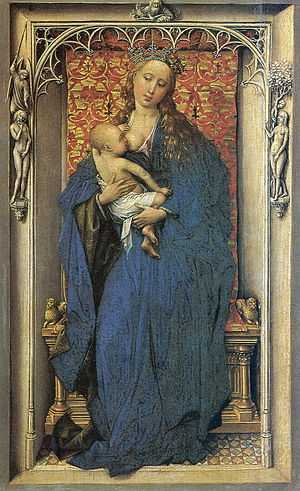
The Madonna Standing, oil on panel, circa 1430-1432. The left wing of the Diptych with the Virgin and Child Standing in a Niche, and Saint Catherine in a landscape in the Kunsthistorisches Museum, Vienna
Sources
References
- ↑ 1.0 1.1 Although the St. Catherine panel is usually attributed to a workshop member, based design by van der Weyden. See Panofsky, 251
- ↑ Blum, 121
- ↑ 3.0 3.1 3.2 3.3 3.4 Ward, 354
- ↑ 4.0 4.1 Ward, 356
- ↑ 5.0 5.1 Ward, 355
- ↑ 6.0 6.1 6.2 6.3 Panofsky, 146
- ↑ 7.0 7.1 7.2 7.3 Blum, 103
- ↑ 8.0 8.1 8.2 8.3 Birkmeyer (1962), 329
- ↑ 9.0 9.1 Acres, 83
- ↑ 10.0 10.1 10.2 Birkmeyer (1962), 330
- ↑ 11.0 11.1 Birkmeyer (1962), 331
- ↑ Acres, 105
- ↑ Ward, 354–356
Bibliography
- Acres, Alfred. "Rogier van der Weyden's Painted Texts". Artibus et Historiae, Volume 21, No. 41, 2000. 75–109, JSTOR
- Blum, Shirley Neilsen. "Symbolic Invention in the Art of Rogier van der Weyden". Journal of Art History, Volume 46, Issue 1–4, 1977. 103–122
- Birkmeyer, Karl M. "The Arch Motif in Netherlandish Painting of the Fifteenth Century". Art Bulletin, XLIII, Part 1, 1961
- Birkmeyer, Karl M. "Two Earliest Paintings by Rogier van der Weyden". The Art Bulletin, Volume 44, No. 4, 1962. 329–331
- Panofsky, Erwin. Early Netherlandish Painting: v. 1. Westview Press, 1971 (new edition). ISBN 978-0064300025
- Ward, John L. "A New Attribution for the Madonna Enthroned in the Thyssen Bornemisza Collection". The Art Bulletin, Volume 50, No. 4, 1968. 354–356
External links
| ||||||||||||||||||||||||||||||||
